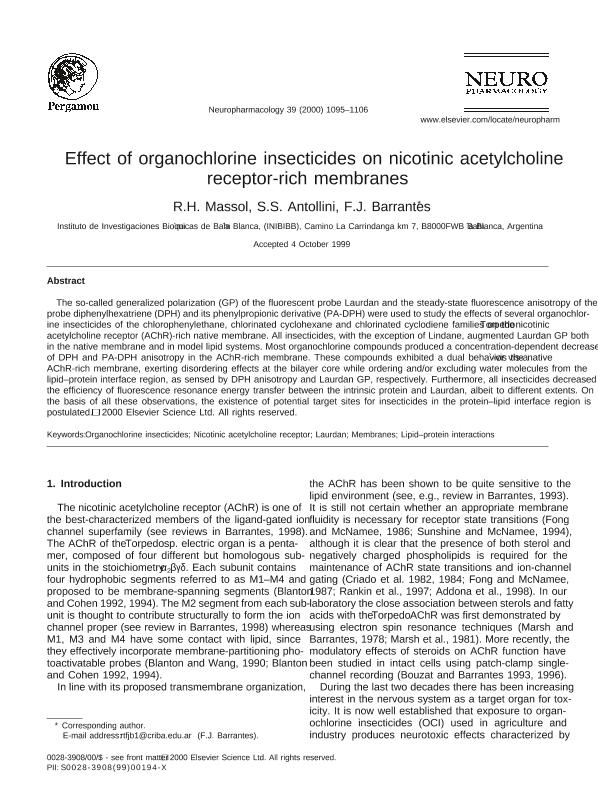Artículo
Effect of organochlorine insecticides on nicotinic acetylcholine receptor-rich membranes
Fecha de publicación:
05/2000
Editorial:
Pergamon-Elsevier Science Ltd
Revista:
Neuropharmacology
ISSN:
0028-3908
Idioma:
Inglés
Tipo de recurso:
Artículo publicado
Clasificación temática:
Resumen
The so-called generalized polarization (GP) of the fluorescent probe Laurdan and the steady-state fluorescence anisotropy of the probe diphenylhexatriene (DPH) and its phenylpropionic derivative (PA-DPH) were used to study the effects of several organochlorine insecticides of the chlorophenylethane, chlorinated cyclohexane and chlorinated cyclodiene families on the Torpedo nicotinic acetylcholine receptor (AChR)-rich native membrane. All insecticides, with the exception of Lindane, augmented Laurdan GP both in the native membrane and in model lipid systems. Most organochlorine compounds produced a concentration-dependent decrease of DPH and PA-DPH anisotropy in the AChR-rich membrane. These compounds exhibited a dual behavior vis-a-vis the native AChR-rich membrane, exerting disordering effects at the bilayer core while ordering and/or excluding water molecules from the lipid-protein interface region, as sensed by DPH anisotropy and Laurdan GP, respectively. Furthermore, all insecticides decreased the efficiency of fluorescence resonance energy transfer between the intrinsic protein and Laurdan, albeit to different extents. On the basis of all these observations, the existence of potential target sites for insecticides in the protein-lipid interface region is postulated.
Archivos asociados
Licencia
Identificadores
Colecciones
Articulos(SEDE CENTRAL)
Articulos de SEDE CENTRAL
Articulos de SEDE CENTRAL
Citación
Massol, R. H.; Antollini, Silvia Susana; Barrantes, Francisco Jose; Effect of organochlorine insecticides on nicotinic acetylcholine receptor-rich membranes; Pergamon-Elsevier Science Ltd; Neuropharmacology; 39; 6; 5-2000; 1095-1106
Compartir
Altmétricas




